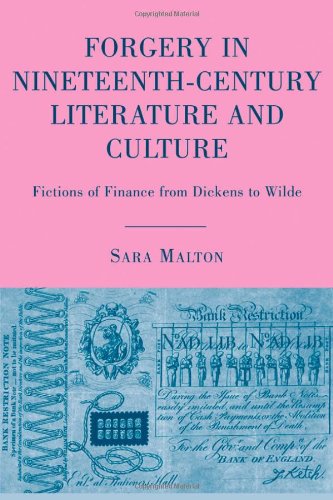[•• = link to material outside this site. Thanks to James Heffernan, founder and editor-in-chief of Review 19 for sharing this review with readers of the Victorian Web. Thackeray created the illuminated “A” for Vanity Fair — George P. Landow.]


art of the Palgrave Studies in Nineteenth-Century Writing and Culture, which includes another literature and law title (Colette Colligan, The Traffic in Obscenity From Byron to Beardsley: Sexuality and Exoticism in Nineteenth-Century Print Culture [2007]), this short collection of essays takes an interdisciplinary approach to questions of identity, trust, and deception in nineteenth-century Britain, showing how illegitimacy prompted new definitions of what is "legitimate" (3). Product of a 2005 conference on legitimacy, this book will interest scholars who study identity, and in particular those who wish to study works by Wilkie Collins, Charles Dickens, George Eliot, and Anthony Trollope in the context of pertinent legal cases or laws (notably the Legitimacy Declaration Act and the Poor Law Amendment Act) that involve identity and legitimacy.
By highlighting imposters, contributors to this collection reveal the instability of the concept of "identity" in both literature and law. As Margot Finn, Josephine McDonagh, and Rohan McWilliam remind us, identities are not just proven; they are also performed, manipulated, perceived, discredited, and in certain cases transformed. Finn raises many questions about identity, lineage, and legitimacy in the nuclear family as she links the family of Sir George Hilaro Barlow to bastards, illegitimate heirs, and the composition of households in England and India. Re-visiting Dickens's Bleak House — a classic of literature and law — McDonagh probes shifting geographies of belonging, identity, and feeling in the ever more bureaucratized state of nineteenth-century Britain. Juxtaposing the novel with George Coode's 1843 parliamentary report on laws of settlement dating back to The Settlement Act of 1662, she finds the novel and the report similarly analyzing the plight of the poor and its causes (55). McWilliam probes "unauthorized identities," showing how the face, the claimant, and the Pretender could be challenged or legitimated by "secret histories." Citing the cases of Olivia Wilmot Serres, Tomas Provis, Richard Hugh Smyth, and Amelia Radcliffe, McWilliam explains what was required--during an age insistent upon detailed evidence--to justify claims of identity. Not only did claimants have to conjure up surreptitious pasts, but imposters constantly needed theatricality to act out their identities.
In the second half of the collection, the focus shifts to legitimate and illegitimate forms of behaviour in the world of commerce and trade and in the world at large. Complementing the analysis of forged identities in the first half of the book, the second half treats some interesting examples of forgery, and the contributors' insistence upon legitimate business practices helps situate current discussions about economic trickery within a longer history that, as Randall McGowen writes of the Fauntleroy Forgeries and the making of white collar crime, may seem "more than a little familiar" (93). Forgery cases, he reminds us, were rare but attracted tremendous attention. Because "social identity became tangled up" in questions about who wrote a particular document, and because such questions had a bearing--and still do--upon ever-growing credit markets, forgery cases led to "the most celebrated trials and executions of the period" (93). Reported in detail to the "millions" who followed it, a forgery case became a bestseller, a story so filled with twists and turns as to make it a veritable serial novel for the reading public.
Michael Lobbon likewise finds a distant mirror of our own market crises in the late nineteenth century, when fraudulent practices accompanied the ever-growing levels of investment in financial assets. He also plots the effect of the new "financial journalism" that reported to investors--including a new class of small investors and an interested public--on details of commercial and industrial investments at home and abroad. Just as the essays of the first half contrast legitimate heirs with imposters or swindlers who undermine a burgeoning system that lacks the safeguards of fail-safe regulation or authentication, the essays of the second half contrast legitimate investment with speculation. As Lobbon explains, Edward Hartmont made a small fortune in the theater by speculating, as producer, on a farce about deception and mistaken identities (!). And in the final essay of the volume, Timothy Alborn shows how trials involving life insurance reflected--over the course of the nineteenth century--changing perceptions of what qualified as legitimate behavior and legitimate contracts (149).
Taken together, this collection certainly demonstrates that just as labyrinthine fictions of legitimacy and illegitimacy sustain the Byzantine plots of Victorians novels such as Bleak House, so too commercial markets exploited the legal loopholes that perforated the wall between legitimate and illegitimate persons, identities, and transactions (173-4). My only regret is that the contributors don't situate their analyses more broadly in a European context, or even an American one. They might, for instance, have compared the British cases or crises with contemporary crises in Paris, such as those documented in Zola's La Curée (1872) and L'Argent (1891). By making their analyses comparative as well as interdisciplinary, contributors to a short and powerful collection like this one could increase its value.
Bibliography
Legitimacy and Illegitimacy in Nineteenth-Century Law, Literature and History. Eds. Margot Finn, Michael Lobban and Jenny Bourne Taylor. Palgrave Macmillan, 2010. viii + 191 pp.
Last modified 23 June 2024